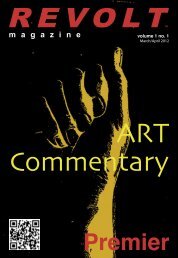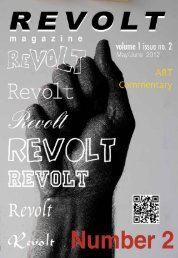Download PDF Version Revolt Magazine, Volume 1 Issue No.4
Download PDF Version Revolt Magazine, Volume 1 Issue No.4
Download PDF Version Revolt Magazine, Volume 1 Issue No.4
You also want an ePaper? Increase the reach of your titles
YUMPU automatically turns print PDFs into web optimized ePapers that Google loves.
JEAN-MICHEL BASQUIAT, Untitled (Two Heads on Gold), 1982, Acrylic and oil paintstick on canvas, 80 x 125 inches, (203.2 x 317.5 cm). Photos courtesy Gagosian Gallery, New York.<br />
unusual in appearance and clever in their material<br />
combinations. "Cassius Clay," 1982, is an acrylic<br />
and oil stick on canvas; however, the stretcher is a<br />
found wood pallet which creates rounded edges on<br />
the top and bottom, lifted in the center by the pallet's<br />
vertical stringer. Half sculpture, half painting, these<br />
works have a presence that humorously undermines<br />
modern painting and how "high art" ought to look.<br />
Toward the end of his short life, Basquiat's paintings<br />
began to empty out with a haunting fatigue. "Riding<br />
with Death," 1988, is one of the most poignant. A<br />
man, red, rides the barely joined bones of a crawling<br />
skeleton, perhaps his own, in an empty bronze field.<br />
The metallic sheen gives the work a royal dignity as<br />
if the artist had unwittingly bestowed his own last<br />
rites.<br />
with prismatic projections emitted from the eyes<br />
and lips making diamonds in the painting's center.<br />
The symmetry, simplicity, and complimentary colors<br />
of dark blue and orange make the 26-inch square<br />
piece feel iconic.<br />
Geoff McFetridge's medium-sized painting "12<br />
Dots," 2013, depicts twelve individuals from a<br />
bird's eye view. Their heads, each a black circle,<br />
and bodies with limbs are choreographed in a cool<br />
palette of grays, blues and whites, punctuated by a<br />
red shirt or two. The graphic, almost mechanical,<br />
quality of the composition gives the image a slick<br />
iciness, especially since no eye contact is being<br />
made either inside or outside the painting.<br />
Ryan Schneider's "How Long Have You Known?,"<br />
2013, shares a palette similar to Oinonen's, yet it's<br />
more saturated and high-keyed. A topless woman<br />
sunbathes, only partly shaded by palm leaves,<br />
on a red-and-black striped towel with various<br />
fruits around her. As the towel and fruit appear<br />
atilt, leaning unnaturally forward, the painting's<br />
lower half feels like a Matisse still life. It's a nice<br />
effect, even if the crotch-centric composition (and<br />
exaggerated signature) is a tad heavy handed. At the<br />
same time, overstatement seems to authenticate<br />
contemporaneity these days.<br />
Fifty years ago artist-critic Fairfield Porter reviewed a<br />
MoMA exhibition "exploring recent directions in one<br />
CHICKEN OR BEEF?<br />
March 6 - April 20, 2013<br />
The Hole<br />
312 Bowery, NY, NY<br />
If you're "crossing the pond," as international<br />
travelers phrase it, the flight attendant's question<br />
at mealtime could be "Chicken or beef?" Hence the<br />
title of The Hole's mini-survey exhibition of figure<br />
paintings drawn from artists mostly in Europe<br />
and North America. There's no real premise here.<br />
The press release alludes to connecting threads,<br />
but the pleasure in the show is in the disparity of<br />
approaches to representation sustained by an<br />
evenness in quality.<br />
Several artists are widely known, such as Cecily<br />
Brown, Barnaby Furnas, and Jules de Balincourt. The<br />
latter employs a Rubin vase motif (i.e., two facing<br />
silhouettes that make, by illusion, a center vase)<br />
Xstraction: A survey of new approaches in abstraction, installation view. Photos courtesy The Hole, New York.<br />
One knockout piece is "Unopposite," 2012, by aspect of American painting: the renewed interest<br />
Canadian-based artist Anders Oinonen. Keen in the human figure." A figure painter himself, he<br />
sensibilities of abstraction and figuration arise in quickly pointed out that "[s]ince painters have<br />
equal measure in one large saddened, upwardgazing<br />
face. Painted in bright, fine-tuned pastels to represent a renewed interest in the figure on the<br />
never stopped painting the figure...it could be said<br />
strategically modified with angled planes that part of critics and the audiences rather than among<br />
function like scrims or thin white washes, the sevenfoot-tall<br />
painting appears to genuinely emote, albeit painters." I'd like to think that's still true.<br />
painters. To this extent the critics are following the<br />
in a cartoonish way – which is surprising given how<br />
rigorously abstract its composition is.





